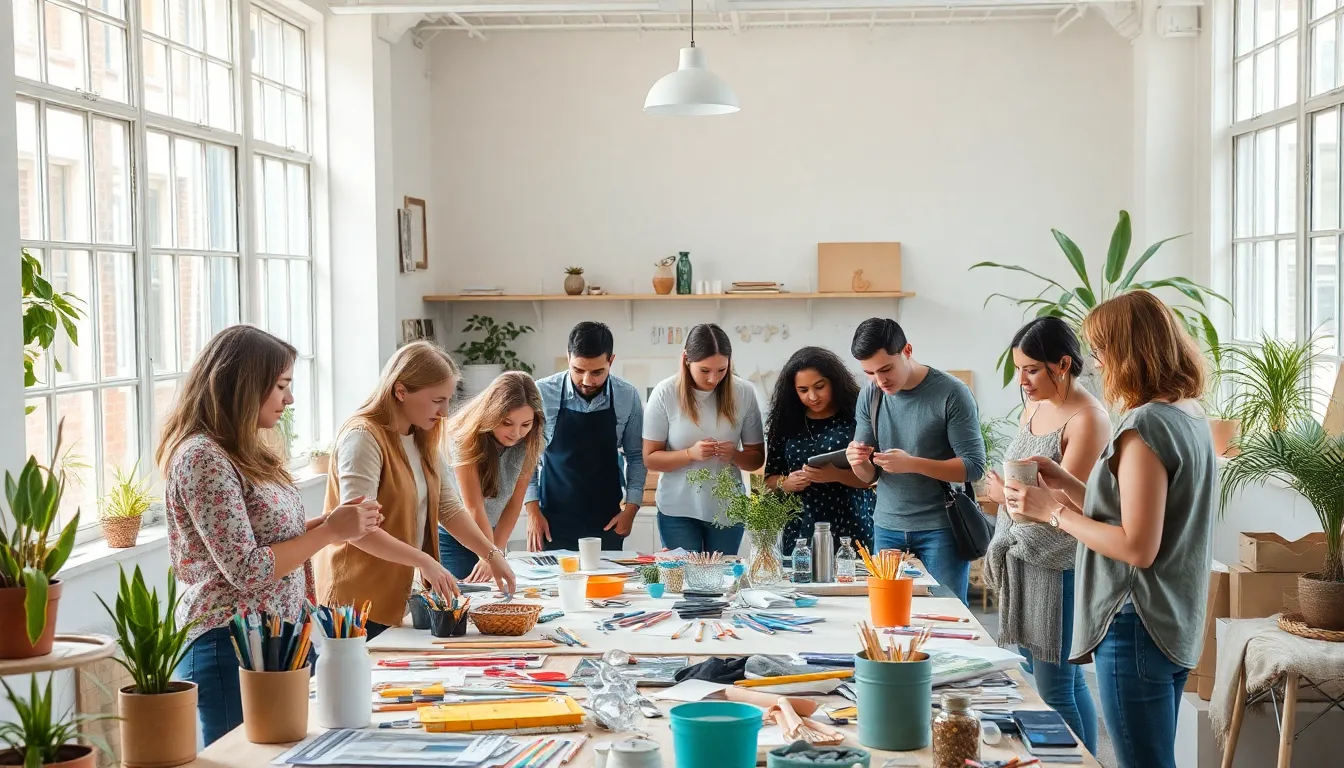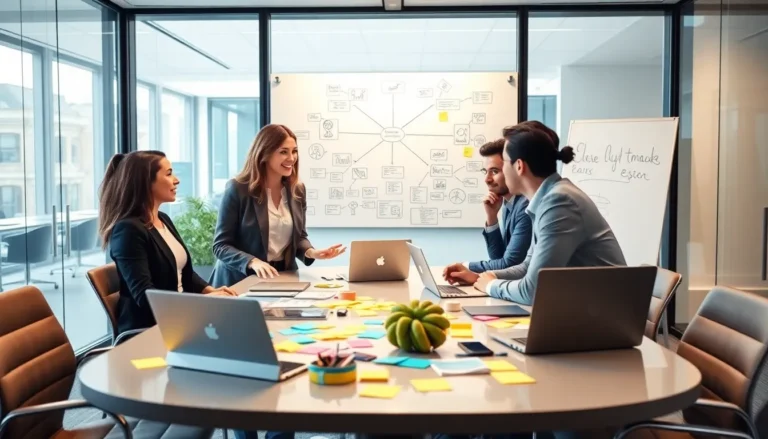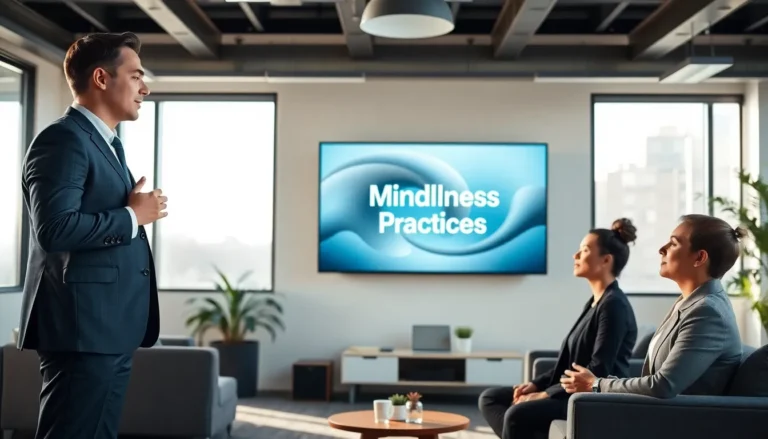Table of Contents
ToggleCreativity can sometimes feel like a shy cat hiding under the couch—hard to coax out but oh-so-rewarding when it finally emerges. In a world that often prioritizes routine over imagination, finding ways to boost creativity is essential. Whether you’re an artist, a writer, or just someone looking to think outside the box, unlocking your creative potential can lead to exciting breakthroughs and fresh ideas.
Understanding Creativity
Creativity represents the ability to generate new, original ideas and solutions. This unique talent manifests in various fields, from art to science.
Definition of Creativity
Creativity refers to the mental process of producing novel concepts or creating something valuable. Characterized by originality and innovation, it involves combining existing knowledge in unique ways. The ability to think outside the box defines creative minds. Examples include composing music, designing graphics, or developing algorithms. Studies demonstrate that innate creativity exists in everyone, though society often hinders expression. Factors such as environment, mindset, and experiences heavily influence creative output.
Importance of Creativity
Creativity plays a vital role in problem-solving and innovation. It drives progress across industries, leading to technological advancements and artistic developments. Businesses increasingly seek imaginative thinkers to enhance competitiveness. In educational settings, creativity fosters critical thinking, allowing students to approach subjects innovatively. Research highlights that creativity also contributes to personal fulfillment and emotional well-being. Engaging in creative activities reduces stress and promotes mental health. By prioritizing creativity, individuals and organizations unlock potential for significant breakthroughs and transformative ideas.
Factors That Influence Creativity

Creativity is shaped by various influences. Understanding these factors provides insight into nurturing one’s creative potential.
Environmental Influences
Environment plays a crucial role in fostering creativity. Bright, open spaces often encourage more innovative thinking. Access to nature can also enhance inspiration, leading to fresh ideas. Noise levels impact focus; moderate background noise might stimulate creativity, while extreme quiet can hinder it. Collaborative environments benefit creativity too, as interacting with others sparks new thoughts. Limitless resources and materials provide opportunities for exploration, promoting creative problem-solving.
Psychological Factors
Psychological state significantly impacts creativity. Confidence boosts individuals’ willingness to take intellectual risks. Stress negatively affects creative output, restricting freedom of thought. Embracing a growth mindset allows for viewing challenges as opportunities, fostering resilience and innovation. Motivation is vital; intrinsic motivation typically drives superior creative performance over extrinsic rewards. Additionally, emotional well-being directly correlates with creative capabilities; positive emotions often lead to enhanced idea generation.
Techniques to Boost Creativity
Implementing techniques to enhance creativity can significantly improve one’s ability to generate original ideas. Various methods exist to stimulate the mind and foster innovation.
Mind Mapping
Mind mapping organizes thoughts visually, allowing for a clearer understanding of concepts. By starting with a central idea, individuals can branch out into subtopics, making connections between various elements. This graphical representation helps in identifying relationships and sparking new ideas, ultimately enhancing creative flow. A well-structured mind map can reveal patterns and connections that might otherwise remain hidden, significantly enriching the brainstorming process.
Brainstorming Sessions
Brainstorming sessions encourage group collaboration, driving the generation of diverse ideas. In a relaxed environment, participants feel more inclined to share their thoughts without fear of judgment. Setting a time limit can create a sense of urgency, prompting individuals to think quickly. Utilizing techniques like round-robin or free-form discussions can also lead to unexpected breakthroughs. Documenting every idea, no matter how unconventional, cultivates an atmosphere of creativity that inspires innovative solutions.
Creative Exercises
Engaging in creative exercises nurtures imaginative thinking and problem-solving skills. Activities like journaling, drawing, or participating in improvisation games stimulate the mind in unique ways. Regular practice of these techniques trains the brain to think outside the box. Additionally, experimenting with different mediums can foster new perspectives and ideas. Incorporating variety into creative routines maximizes potential, making innovation a consistent outcome.
The Role of Technology in Boosting Creativity
Technology plays a crucial role in enhancing creativity across various domains. Digital innovations facilitate new avenues for idea generation and collaboration.
Digital Tools and Apps
Numerous digital tools enhance creative processes. Applications like Adobe Creative Cloud enable designers to produce stunning visual content easily. Tools such as Trello and Asana boost productivity by organizing projects, fostering creativity through structured workflows. Mind mapping software like XMind visually organizes thoughts, making connections clearer and opening new pathways for innovation. Mobile applications, including Canva and Notion, provide convenient platforms for creative expression while on the go. Hence, these tools empower individuals to explore their creative potential effortlessly.
Online Resources
A wealth of online resources nurtures creativity. Websites like Skillshare and Coursera offer courses across various creative disciplines, broadening knowledge and skills. Platforms such as YouTube feature tutorials that teach specific techniques in art, design, and writing. Blogs and forums dedicated to creativity allow individuals to share ideas and collaborate. Social media channels, including Instagram and Pinterest, serve as inspirational hubs, showcasing innovative work and trends. Ultimately, these resources connect like-minded individuals, sparking new ideas and enriching creative endeavors.
Examples of Successful Creativity Boosting
Numerous examples illustrate how creativity boosts have led to remarkable outcomes in various fields.
Case Studies
A notable case is the design firm IDEO, which pioneered human-centered design methods. Their innovative brainstorming sessions invite diverse perspectives, resulting in groundbreaking products like the Apple computer mouse. Another influential example is Google, renowned for its 20% time policy. Employees dedicate this time to personal projects, fostering creativity that has led to successful ventures like Gmail and AdSense. Companies that embrace open collaboration and allocate resources towards creative exploration consistently achieve heightened innovation levels.
Inspirational Stories
Thomas Edison’s relentless experimentation truly exemplifies creative perseverance. He famously stated that genius is 1% inspiration and 99% perspiration, highlighting the importance of persistence. Frida Kahlo, the Mexican artist, transformed personal pain into remarkable artworks. Her unique style and perspective inspired countless individuals and changed the art landscape. These stories underscore that creativity thrives not merely from ideation but also from the courage to explore and express one’s innermost thoughts and experiences.
Embracing creativity is essential for personal and professional growth. By understanding the factors that influence creative expression and implementing effective techniques, individuals can unlock their full potential. The right environment and mindset can transform the way one approaches challenges, leading to innovative solutions and breakthroughs.
Creativity isn’t just for artists; it’s a vital skill in every field. Those who prioritize creative thinking often find themselves at the forefront of progress and innovation. By nurturing creativity through collaboration and exploration, both individuals and organizations can thrive in an ever-evolving landscape.




